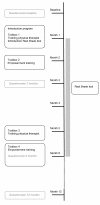A worksite prevention program for construction workers: design of a randomized controlled trial
- PMID: 20546568
- PMCID: PMC2896359
- DOI: 10.1186/1471-2458-10-336
A worksite prevention program for construction workers: design of a randomized controlled trial
Abstract
Background: A worksite prevention program was developed to promote the work ability of construction workers and thereby prolong a healthy working life. The objective of this paper is to present the design of a randomized controlled trial evaluating the effectiveness of that intervention program compared with usual care for construction workers.
Methods: The study is designed as a randomized controlled trial with a follow-up of one year. Employees eligible for this study are construction workers performing actual construction work. The worksite intervention will be compared with usual care. This intervention was developed by using the Intervention Mapping approach and consists of the following components: (1) two individual training sessions of a physical therapist to lower the physical workload, (2) a Rest-Break tool to improve the balance between work and recovery, and (3) two empowerment training sessions to increase the influence of the construction workers at the worksite. Outcome measures are assessed at baseline, 3, 6, and 12 months. The primary outcome measures of this study are work ability and health-related quality of life. Secondary outcome measures include need for recovery, musculoskeletal complaints, work engagement and self efficacy. Cost-effectiveness will be evaluated from the company perspective. Moreover, a process evaluation will be conducted.
Discussion: The feasibility of the intervention and the study has been enhanced by creating an intervention program that explicitly appeals to construction workers and will not interfere too much with the ongoing construction. The feasibility and effectiveness of this worksite prevention program will be investigated by means of an effect- and a process evaluation. If proven effective, this worksite prevention program can be implemented on a larger scale within the construction industry.
Trial registration: NTR1278.
Figures
Similar articles
-
Effectiveness of an intervention at construction worksites on work engagement, social support, physical workload, and need for recovery: results from a cluster randomized controlled trial.BMC Public Health. 2012 Nov 21;12:1008. doi: 10.1186/1471-2458-12-1008. BMC Public Health. 2012. PMID: 23171354 Free PMC article. Clinical Trial.
-
Intervention Mapping as a framework for developing an intervention at the worksite for older construction workers.Am J Health Promot. 2011 Sep-Oct;26(1):e1-10. doi: 10.4278/ajhp.100326-QUAL-88. Am J Health Promot. 2011. PMID: 21879927
-
Cost-effectiveness of a participatory return-to-work intervention for temporary agency workers and unemployed workers sick-listed due to musculoskeletal disorders: design of a randomised controlled trial.BMC Musculoskelet Disord. 2010 Mar 28;11:60. doi: 10.1186/1471-2474-11-60. BMC Musculoskelet Disord. 2010. PMID: 20346183 Free PMC article. Clinical Trial.
-
The effectiveness of a construction worksite prevention program on work ability, health, and sick leave: results from a cluster randomized controlled trial.Scand J Work Environ Health. 2013 Sep 1;39(5):456-67. doi: 10.5271/sjweh.3361. Epub 2013 Apr 8. Scand J Work Environ Health. 2013. PMID: 23567980 Clinical Trial.
-
Workplace interventions for increasing standing or walking for decreasing musculoskeletal symptoms in sedentary workers.Cochrane Database Syst Rev. 2019 Nov 17;2019(11):CD012487. doi: 10.1002/14651858.CD012487.pub2. Cochrane Database Syst Rev. 2019. PMID: 31742666 Free PMC article.
Cited by
-
Effectiveness of an intervention at construction worksites on work engagement, social support, physical workload, and need for recovery: results from a cluster randomized controlled trial.BMC Public Health. 2012 Nov 21;12:1008. doi: 10.1186/1471-2458-12-1008. BMC Public Health. 2012. PMID: 23171354 Free PMC article. Clinical Trial.
-
Clustering of risk factors for non-communicable disease and healthcare expenditure in employees with private health insurance presenting for health risk appraisal: a cross-sectional study.BMC Public Health. 2013 Dec 21;13:1213. doi: 10.1186/1471-2458-13-1213. BMC Public Health. 2013. PMID: 24359466 Free PMC article.
-
Quality of life and probable psychological distress among male workers at a construction site, Kolar district, Karnataka, India.Indian J Occup Environ Med. 2016 Jan-Apr;20(1):54-9. doi: 10.4103/0019-5278.183846. Indian J Occup Environ Med. 2016. PMID: 27390481 Free PMC article.
-
The impact of common mental disorders on work ability in mentally and physically demanding construction work.Int Arch Occup Environ Health. 2014 Jan;87(1):51-9. doi: 10.1007/s00420-012-0837-6. Epub 2012 Dec 20. Int Arch Occup Environ Health. 2014. PMID: 23254510
-
A Cluster Randomized Controlled Trial of a Total Worker Health® Intervention on Commercial Construction Sites.Int J Environ Res Public Health. 2018 Oct 25;15(11):2354. doi: 10.3390/ijerph15112354. Int J Environ Res Public Health. 2018. PMID: 30366387 Free PMC article. Clinical Trial.
References
-
- Welch LS. Improving work ability in construction workers--let's get to work. Scand J Work Environ Health. 2009;35:321–324. - PubMed
-
- Gould R, Ilmarinen J, Järvisalo J, Koskinen S, editors. Dimension of work ability: results of the Health 2000 Survey. Helsinki: Finnish Centre of Pensions, The Social Insurance Institution, National Public Health Institute, Finnish Institute of Occupational Health; 2008.
-
- Ilmarinen J. Work ability--a comprehensive concept for occupational health research and prevention. Scand J Work Environ Health. 2009;35:1–5. - PubMed
-
- Ilmarinen J. Ageing workers in the European Union - Status and promotion of work ability, employability and employment. Helsinki: Finnish Institute of Occupational Health, Ministry of Social Affaire and Health, Ministry of Labour; 1999.
Publication types
MeSH terms
LinkOut - more resources
Full Text Sources
Medical


